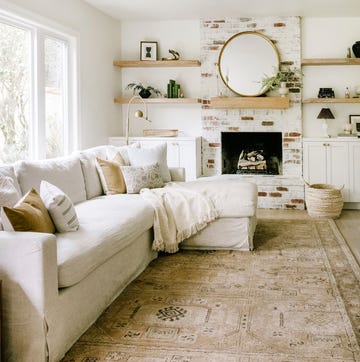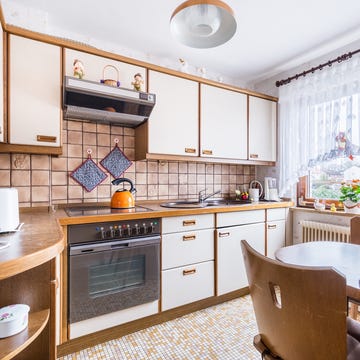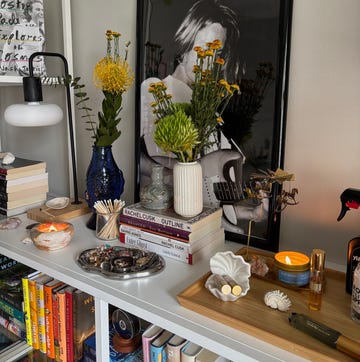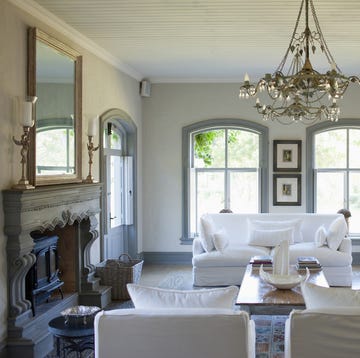In the era when “Must See TV” reigned supreme and Britney Spears ruled the airwaves, decor was also having its own moment, through earthy neutrals, soft pastels, overstuffed furniture, and floral fabrics. Although the 1990s can be a polarizing time period for interior design enthusiasts (some loved it while others still bemoan certain trends), for better or for worse, the decade is back, and is making its way into today’s spaces.
As a girl who was all about celestial decor and sunflower everything, I’m personally excited that the interior design of my childhood is making a comeback, and some designers agree.
“When done right, the return of the 90s in interiors isn’t about kitsch—it’s about reclaiming the warmth, comfort, and unpretentious charm of the era, all through the lens of modern living,” says Lindsie Davis, founder and principal designer of Blueberry Jones Design.
If you’re drawn to 90s design but don’t want your home to look like a time capsule right out of an episode of Full House, how should you (tastefully) capture the look?
Why Are the 90s Trending?
“Everything 90s is back in fashion,” says interior designer Ross Cassidy, something he attributes to younger generations rediscovering the show Friends during the pandemic, and it’s built up from there.
Davis believes that the 90s have returned because, much like fashion, interior design trends move in 30-year cycles, and the decade is right on schedule for a revival.
“What felt dated a decade ago now reads as charming and fresh,” Davis says. “Millennials, many of whom grew up in 90s homes, are tapping into the warm familiarity of their childhood while updating it for adulthood, but with a more refined, edited eye.”
Social media has additionally added fuel to the fire, with users showing off their 90s vintage finds from thrift stores and even recreating their childhood bedrooms.
Hallmarks of 90s Design
- Rounded, overstuffed furniture. “In the 90s, rounded, overstuffed furniture was all about comfort-first living, with puffy roll-arm sofas, oversized sectionals and barrel chairs dominating living rooms,” Davis says. “Today, that same inviting shape has been reimagined with low-slung curved sofas upholstered in velvet or performance linen, modular sectionals with generous cushions and sculptural barrel chairs in leather, textured weaves or even a bold pattern.”
- Chintz. Interior designer Alexandra Kaehler associates 90s decor with chintz, but back then, the chintz seemed to always have “a tea-stained background or the [wallpaper] borders either felt juvenile or too fussy,” she reflects. Today, she says that chintz is coming back, but this time, it has an element of crispness, especially when paired with unexpected time periods or showcased with creamy textiles acting as a backdrop.
- Honey wood tones. Although honey oak kitchen cabinets once dominated the 90s decor scene, nowadays, the sunny hue is reemerging through European oak flooring, fluted bathroom vanities, and cane-front credenzas. “Pairing these woods with matte surfaces, blackened hardware, and contemporary silhouettes immediately strip away the dated feel and highlight their natural beauty,” Davis says.
- Glass and chrome accents. Pointing out that glass and chrome details were once a 90s decor staple, today, Davis says that the look has “evolved into more sculptural, design-conscious pieces,” for example, a glass tabletop resting on statement bases in brass or blackened steel, airy glass pendant lights suspended over kitchen islands, or streamlined shelving units that keep sightlines open.
How to Pull off 90s Design Trends
✔️ Layer eras. If you’d like to take the plunge into 90s decor, lean toward thoughtful curation. Davis says that it’s key to avoid going “head-to-toe in era-specific pieces.” Instead, she recommends layering 90s accents with items from other periods. For instance, you can pair a rounded 90s sofa reupholstered with a fresh fabric with sleek contemporary lighting or sculptural side tables for contrast.
✔️ Value quality. To bring vintage pieces of any kind into your spaces, from the 90s and beyond, Cassidy says you should opt for high-quality vintage items that are timeless. “If it was vintage and it worked in the 90s, it worked in the decades prior and post,” he says.
✔️ Play with color. “Integrate one or two 90s-inspired hues into a modern scheme, like sage green kitchen cabinets or a dusty rose accent chair,” Davis says.
✔️ Stick with the classics. Cassidy shares that he was “obsessed with Frasier Crane’s apartment in the 90s,” believing it was the height of good taste. But now, he thinks it actually looks dated. But when looking at images of Will’s apartment from Will & Grace, he says that it’s aged well and is “perfection” since it avoided trends. For this look, don’t go for the trendy stuff from the period and instead opt for classics in earthy hues, which still nods to the 90s.
Shelby Deering is a freelance lifestyle writer who frequently covers home design and decor for national publications. She has worked as a full-time freelance writer for over a decade, and has worked in the industry for nearly 20 years, writing home tours, interviewing top designers, and beautifying her own home. She holds a master's degree in Journalism and Mass Communication from the University of Wisconsin-Madison, and when she's not writing, you can find her at thrift stores and flea markets, running, or exploring local trails in Madison, Wisconsin, with her husband and corgi, Dolly.
















